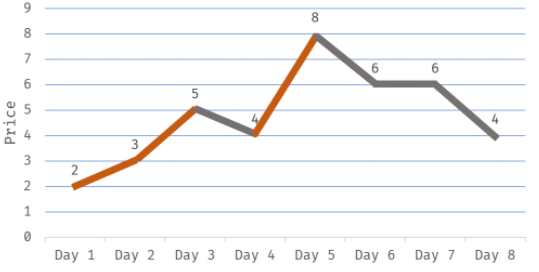122.Best Time to Buy and Sell Stock II

class Solution: def maxProfit(self, prices: List[int]) -> int: length = len(prices) if length == 0: return 0 minBuyPrice = prices[0] maxProfit = 0 for i in range(1, length): if prices[i] < prices[i-1] and prices[i-1] > minBuyPrice: maxProfit += prices[i-1] - minBuyPrice minBuyPrice = prices[i] if prices[i] < minBuyPrice: minBuyPrice = prices[i] if prices[length-1] > minBuyPrice: maxProfit += prices[length-1] - minBuyPrice return maxProfit
Java 版:
• 贪心算法(方法一);
• 所有上涨交易日都买卖(相当于上涨第一天买,上涨最后一天卖,只是代码中表现为每一天都既买又卖),所有下降交易日都不买卖,防止亏钱。

class Solution { public int maxProfit(int[] prices) { int res = 0; for (int i = 1; i < prices.length; i++) { int tmp = prices[i] - prices[i - 1]; //表示上涨 if (tmp > 0) res += tmp; } return res; } }
• 动态规划(方法二):
• 每一天只能交易一次,所以第 i天要么不持有股票、要么持有股票,只有这两种状态,则用一个二维数组来表示, dp[i][0]表示不持有股票时手里的钱、dp[i][1]表示持有股票且手里剩余的钱;
• 最开始,第一天,设手中的钱为 0,即 dp[0][0] = 0,则手中持有股票后剩余的钱为: 0 - prices[0] = -2 ,相当于垫付 2元来买股票,欠股票市场 2 元,先欠着,等后面卖出去后来还;
• 第 i天时,dp[i][0]要么继承自dp[i-1][0],要么为第 i天将之前持有的股票以第 i天的价格抛售卖出后的收益,两者取最大值;
• 同理,dp[i][1]要么为继承自 dp[i-1][1]的股票,要么第 i天现买的股票,取买完股票后手中剩余钱最多的;
• 手里持有股票,且剩余的钱最多,相当于股票的买入价格越低,也是局部最优的。
class Solution { public int maxProfit(int[] prices) { int n = prices.length; int[][] dp = new int[n][2]; dp[0][1] = -prices[0]; //持有股票,手里剩余的钱,初始没钱,就是负的 for(int i = 1; i < n; i++){ dp[i][0] = Math.max(dp[i-1][0], dp[i-1][1] + prices[i]); //dp[i-1][1] + prices[i] 表示上一次手中持有股票且剩余的钱 + 以今天价格抛售能获得的钱 dp[i][1] = Math.max(dp[i-1][1], dp[i][0] - prices[i]); //dp[i][0] - prices[i] 表示以今天的价格prices[i]买入股票后,剩余的钱 } return dp[n-1][0]; } }



